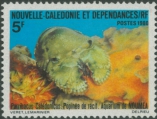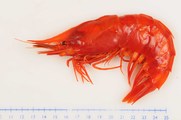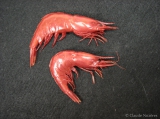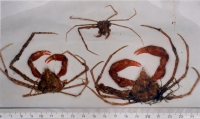Decanet taxon details
Orconectes stygocaneyi Hobbs, 2001
1780487 (urn:lsid:marinespecies.org:taxname:1780487)
accepted
Species
Faxonius stygocaneyi (Hobbs, 2001) · unaccepted > superseded combination
Orconectes (Orconectes) stygocaneyi Hobbs, 2001 · unaccepted > superseded combination
recent only
(of Orconectes (Orconectes) stygocaneyi Hobbs, 2001) Hobbs, H.H., III. (2001). A new cave crayfish of the genus <i>Orconectes</i>, subgenus <i>Orconectes</i>, from Southcentral Missouri, U.S.A., with a key to the stygobitic species of the genus (Decapoda, Cambaridae). <em>Crustaceana.</em> 74(7): 635-646., available online at https://doi.org/10.1163/156854001750377911 [details] Available for editors 
DecaNet eds. (2025). DecaNet. Orconectes stygocaneyi Hobbs, 2001. Accessed at: https://www.decanet.info/aphia.php?p=taxdetails&id=1780487 on 2025-09-13
Date
action
by
original description
(of Orconectes (Orconectes) stygocaneyi Hobbs, 2001) Hobbs, H.H., III. (2001). A new cave crayfish of the genus <i>Orconectes</i>, subgenus <i>Orconectes</i>, from Southcentral Missouri, U.S.A., with a key to the stygobitic species of the genus (Decapoda, Cambaridae). <em>Crustaceana.</em> 74(7): 635-646., available online at https://doi.org/10.1163/156854001750377911 [details] Available for editors 
From editor or global species database
Classification Dooley et al. (2022) provide a phylogeny that at least for the 16S gene shows this species does indeed belong with the cave Orconectes. However, their COI data suggests that it might actually better fit with the Cambarus. Regardless, it does not seem to fit well with Faxonius. So based on this current information, we are placing this species back into the genus Orconectes until more data are available to confirm or refute this placement. [details]
To European Nucleotide Archive, ENA (Faxonius stygocaneyi) (from synonym Faxonius stygocaneyi (Hobbs, 2001))
To GenBank (5 nucleotides; 4 proteins) (from synonym Faxonius stygocaneyi (Hobbs, 2001))
To USNM Invertebrate Zoology Arthropoda Collection (1 record) (from synonym Orconectes (Orconectes) stygocaneyi Hobbs, 2001)
To USNM Invertebrate Zoology Arthropoda Collection (Holotype USNM 308991) (from synonym Orconectes (Orconectes) stygocaneyi Hobbs, 2001)
To GenBank (5 nucleotides; 4 proteins) (from synonym Faxonius stygocaneyi (Hobbs, 2001))
To USNM Invertebrate Zoology Arthropoda Collection (1 record) (from synonym Orconectes (Orconectes) stygocaneyi Hobbs, 2001)
To USNM Invertebrate Zoology Arthropoda Collection (Holotype USNM 308991) (from synonym Orconectes (Orconectes) stygocaneyi Hobbs, 2001)



